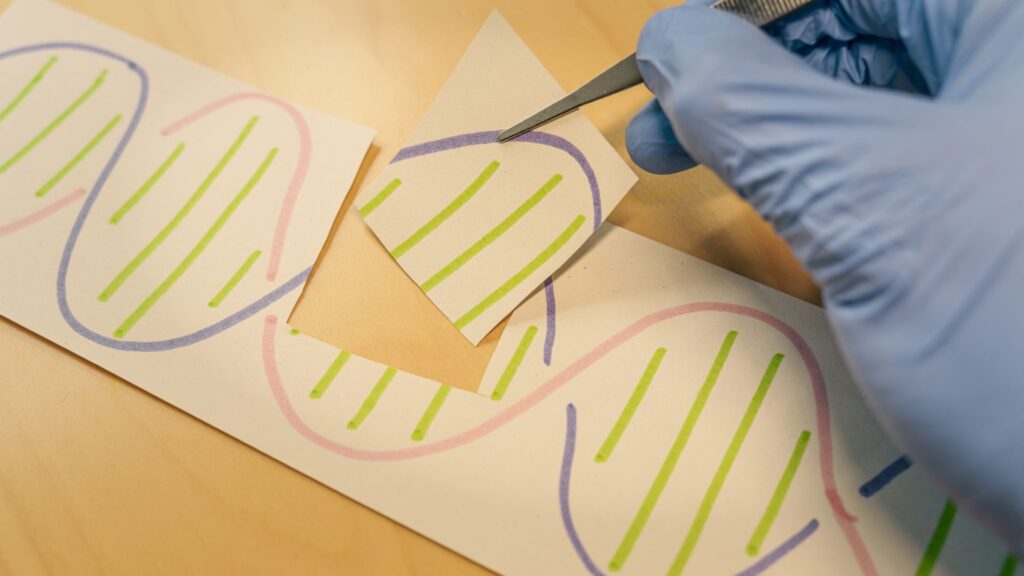Everyone wants to live a long, healthy life. But as we age, our bodies begin to show signs of wear and tear, leaving many searching for ways to slow down this process. What if there was a way to slow down aging and also reverse it? Recent studies have shown that certain therapies and supplements could be the key.
One exciting area of research focuses on removing senescent cells — old cells that no longer function as they should. Scientists think getting rid of these cells can help us look and feel younger.
This article will explore how gene therapy, senolytic drugs, and specific nutrients might turn back time on cellular aging, offering hope for extended vitality.
Ready for a glimpse into the future of living healthier, longer? Read on.
Key Takeaways
- Scientists like Dr. George Church use CRISPR/Cas9 gene editing to fight aging by changing or removing old cells that no longer divide.
- Senolytics, including fisetin and quercetin, are special compounds that can clear out these aging cells, potentially making us live longer and healthier.
- Research shows targeting senescent cells slows aging and could reverse some effects of getting older.
- Fisetin, found in strawberries, is a key nutrient that helps remove old cells and has been made more powerful in new formulas.
- Combining different senolytics like fisetin with quercetin might lead to even better results for health and extending lifespan.
Understanding Aging and Cellular Senescence

Aging happens when our cells get old and don’t work like they used to. Targeting these tired cells might just be the secret to turning back the clock.
The role of senescent cells
Senescent cells play a crucial role in aging and deterioration of the body. These cells stop dividing but do not die off, accumulating in tissues over time. Their presence triggers inflammation, damages nearby healthy cells, and contributes to age-related diseases.
Research has shown that removing senescent cells can slow or even reverse aspects of aging, making them key targets for life extension strategies.
Senolytics are compounds that remove senescent cells associated with slowing or reversing certain aspects of aging.
With advances in gene therapy and discoveries like fisetin—a potent senolytic compound proven to destroy these troublesome cells—the science community sees a promising pathway towards human rejuvenation and extended lifespan, highlighting the pivotal role senescent cells play in our pursuit of longevity.
Effects of cellular senescence on aging
Moving from understanding the role senescent cells play, we see how cellular senescence impacts aging directly. Senescent cells accumulate in our bodies as we age, releasing harmful substances that cause inflammation and tissue damage.
This process speeds up aging and contributes to diseases associated with getting older, like heart disease and diabetes.
Research has shown that removing these senescent cells slows down aging. For instance, studies on mice have demonstrated extended lifespans thanks to drugs that target these cells for elimination.
Scientists, including Harvard’s Dr. George Church, are exploring gene therapy techniques such as CRISPR/Cas9 to transform or remove senescent cells effectively. The goal is clear: reduce the burden of aged cells to reverse aspects of aging and significantly improve health span.
Importance of targeting senescent cells
From the effects of cellular senescence on aging, we shift focus to why targeting these senescent cells is crucial. Senolytics, as highlighted in preclinical studies, serve a pivotal role by removing these problematic cells.
The process slows down aging and has shown signs of reversing certain aspects of it. Dr. George Church’s work with CRISPR technology underscores this by aiming to transform senescent cells fundamentally.
Fisetin stands out among compounds for its potent senolytic activity; research indicates it can destroy these detrimental cells and thus extend lifespan. With advancements like a new formulation enhancing fisetin’s bioavailability, targeting senescent cells offers a promising path toward delaying and even reversing the aging process—a goal firmly within geroscience’s reach.
The Power of Senolytics

Senolytics are making waves by targeting and removing cells that cause aging. They promise a healthier life by clearing out what our bodies no longer need.
Definition of senolytics
Senolytics are groundbreaking compounds with the power to target and eliminate senescent cells. These cells contribute to aging by ceasing to divide and releasing harmful substances that cause inflammation.
Through preclinical studies, researchers have discovered that removing these non-dividing cells can slow or even reverse aspects of aging, making senolytics a key player in the quest for life extension.
Harvard researcher Dr. George Church has been at the forefront of using CRISPR/Cas9 gene editing technology to transform senescent cells, showcasing its potential in anti-aging therapy.
Fisetin, identified as a potent senolytic compound, has shown promise in destroying these detrimental cells and extending lifespan. Its effectiveness is enhanced in new formulations designed for increased bioavailability, marking significant progress in anti-aging research and pushing the boundaries of what’s possible in life extension practices.
How they work to remove senescent cells
Senolytics target and destroy aging cells that no longer divide but refuse to die. These old cells release harmful chemicals, causing damage and leading to diseases. By eliminating them, senolytics help rejuvenate tissues and improve health.
For instance, fisetin has been identified as a powerful senolytic, shown in studies to flush out these problematic cells, thus potentially extending lifespan.
Harvard researcher Dr. George Church’s work with CRISPR technology offers another angle on removing senescent cells. This gene editing approach could directly transform aged cells into healthier versions or eliminate them entirely.
With ongoing research into compounds like quercetin and gene therapies for anti-aging, the potential for substantially extending healthy years of life becomes more tangible. The discussion naturally transitions to the benefits associated with these therapies next.
Benefits of senolytic therapies
Senolytic therapies offer a groundbreaking approach to slowing down the aging process. These treatments effectively target and remove senescent cells, which contribute to age-related decline.
By clearing out these dysfunctional cells, senolytic therapies can significantly improve health span, reduce the risk of chronic diseases, and even extend lifespan. Studies have shown promising results in preclinical settings, indicating potential for real-world applications in human longevity.
Exploring this avenue further could harness supplements like fisetin and quercetin alongside advanced gene-editing technologies such as CRISPR/Cas9 developed by Harvard researcher Dr. George Church. This combination presents an exciting frontier in anti-aging research with a focus on not just extending life but enhancing its quality. The integration of natural compounds and cutting-edge science ushers us into the next topic: Promising Senolytic Nutrients.
Promising Senolytic Nutrients
Discover natural ways to keep your body young with promising senolytic nutrients that tackle aging cells head-on. Keep reading to learn how these powerhouses can revitalize your health from within.
Fisetin
Fisetin stands out as a powerful ally in the fight against aging. This potent senolytic nutrient, found in strawberries and other fruits, has shown remarkable ability to clear away senescent cells—the ones that contribute to aging and decline.
Research highlights its efficacy in extending lifespan, making it a key focus for those aiming to push the boundaries of life extension.
Fisetin is a game changer in the quest for longevity, proven to destroy senescent cells and potentially extend lifespan.
Harvard researcher Dr. George Church’s work sheds light on how enhanced fisetin formulations could further boost bioavailability and effectiveness. With such scientific backing, fisetin emerges not just as another supplement but as a critical component of anti-aging strategies focused on cellular rejuvenation and overall health enhancement.
Quercetin
Quercetin stands out as a powerful nutrient in the fight against aging. This natural compound works by targeting and removing senescent cells—those cells that have stopped dividing and contribute to aging symptoms.
Research shows quercetin helps clear these unwanted cells and has potential benefits for extending lifespan and improving health. It’s a key player alongside other anti-aging compounds, showing promising results in preclinical studies for slowing down or even reversing aspects of aging.
This substance is found in many fruits and vegetables, making it an accessible option for those looking to incorporate senolytic supplements into their regimen. By focusing on eliminating senescent cells, quercetin supports the body’s natural processes, offering a hopeful avenue towards life extension and rejuvenation.
Its role is crucial within geroscience, where the goal is to enhance healthspan, reduce age-related diseases, and extend life through targeted interventions like gene therapy and senolytic therapies.
Tocotrienols + quercetin
Tocotrienols and quercetin team up as a dynamic duo in the quest for life extension. These nutrients pack a powerful punch against cellular aging. Tocotrienols, part of the vitamin E family, work alongside quercetin to clear out senescent cells – those old cells that refuse to die and can lead to tissue damage over time.
This combination has caught the attention of researchers for its potential to significantly extend lifespan.
Studies suggest that when tocotrienols are combined with quercetin, they enhance each other’s effects in flushing away aging cells. Harvard researcher Dr. George Church has highlighted the importance of removing senescent cells as part of reversing the aging process.
The pairing helps rid the body of these detrimental cells and supports overall health by protecting against age-related diseases. Their potential goes beyond simply adding years to life; it’s about enriching those years with better health and vitality.
Potential for extended lifespan
Life extension and reversing aging are no longer just dreams, thanks to groundbreaking research. Scientists like Dr. George Church from Harvard have been leading the charge with gene editing technology such as CRISPR/Cas9.
This technology holds the key to halting and potentially reversing cellular senescence, a major cause of aging. By targeting and transforming senescent cells, these innovations present a real possibility for extending human lifespan significantly.
Senolytic compounds like fisetin are making waves in anti-aging research by showing they can destroy aging cells and boost longevity. New formulations of fisetin improve its bioavailability, making it more effective than ever before.
With ongoing advancements in gene therapy and pharmacological interventions aimed at preventing age-related diseases, we’re standing on the brink of a time where extended lifespans could become a widespread reality.
Innovative Approaches to Anti-Aging Gene Therapy
Gene therapy stands at the forefront of anti-aging science, exploring new ways to turn back the clock on aging cells. Researchers are now harnessing CRISPR technology to edit genes and potentially reverse human aging, setting the stage for groundbreaking treatments in rejuvenation.
Gene editing with CRISPR technology
Harvard researcher Dr. George Church has introduced CRISPR/Cas9, a groundbreaking gene editing technology with the power to transform senescent cells. This innovative approach could revolutionize anti-aging research by offering a method for human rejuvenation and potentially reversing aging.
The precision of CRISPR allows scientists to target specific areas of DNA for editing, correcting mutations that contribute to aging and age-related diseases. Dr. Church’s work highlights the potential of this technology not just in extending lifespan but also improving the quality of life.
CRISPR/Cas9 isn’t just a tool for cutting DNA; it’s paving the way for an era where we can edit out aging itself. – Dr. George Church
Through these advancements, gene therapy is emerging as a crucial player in the battle against aging. It holds promise for treating age-related conditions and enabling humans to potentially reverse aspects of aging itself—ushering in new possibilities in longevity and regenerative medicine.
Human rejuvenation
Human rejuvenation is stepping out of science fiction and into reality, thanks to pioneers like Dr. George Church. His work with CRISPR/Cas9 gene editing technology marks a groundbreaking shift to reversing aging.
This approach aims at transforming senescent cells that contribute to age-related decline, offering a glimpse at the possibility of not just slowing, but actually reversing the aging process.
The excitement around this technology stems from its potential to extend life by directly targeting the cellular mechanisms that drive aging.
Dr. Church’s research paves the way for therapies that could ultimately reset our biological clocks. By modifying genes responsible for aging and senescence, these innovative treatments promise a future where diseases related to aging become manageable or even preventable.
This leap forward in gene therapy brings us closer to achieving longer, healthier lives and reshapes our understanding of human longevity.
Next, we examine Dr. George Church’s pioneering efforts in this field….
Potential for reversing aging
Scientists, like Dr. George Church from Harvard, are pioneering gene therapy technologies with groundbreaking potential for reversing aging. This innovation uses CRISPR/Cas9 to edit genes, aiming at transforming senescent cells—those cells that have stopped dividing and contribute to aging symptoms.
The approach promises not just a slowdown but a reversal of the aging process, bringing us closer to achieving human age reversal.
With ongoing research and significant advancements in this field, there is real optimism about extending human lifespan and improving quality of life. These gene therapies target the biological mechanisms of aging at their core—offering hope for eradicating age-related diseases and potentially resetting our biological clocks.
The collaboration across science fields brings together experts in genetics, gerontology, and regenerative medicine to unlock these anti-aging secrets.
Dr. George Church’s Pioneering Work
Dr. George Church leads the charge in using gene therapy for turning back our biological clocks. His studies on fisetin show promise for a future where aging might be reversible.
Leading the way in gene therapy for aging reversal
Harvard researcher George Church has made significant strides in gene therapy for aging reversal. With the development of CRISPR/Cas9 technology, he opened new doors to transforming senescent cells, aiming at a future where human rejuvenation is not just a possibility but a reality.
His work highlights gene editing’s potential to reverse aging processes that were once thought irreversible.
The promise of gene therapy in reversing the aging process is immense, says Dr. Church. He emphasizes fisetin’s role, a compound found to increase lifespan and destroy senescent cells with improved formulations enhancing its bioavailability. This innovative approach combines the precision of gene editing with nature’s own mechanisms for fighting age, marking a pivotal shift in our quest for longevity and anti-aging solutions.
Benefits of fisetin for anti-aging
Fisetin, a potent senolytic compound, has shown to effectively destroy senescent cells. Studies highlight its capability to extend lifespan significantly. With advances in technology, Dr.
George Church’s lab has increased fisetin’s bioavailability, enhancing its anti-aging effects more than ever before. This breakthrough could be a cornerstone in life extension research, giving many the hope of reversing aging and living healthier lives longer.
Proven by preclinical studies to slow or reverse aspects of aging, fisetin stands at the forefront of age-reversal supplements. Its impact on cellular health is profound—targeting and removing cells that contribute to aging-related decline.
Through such mechanisms, fisetin promises an extended lifespan and improves quality of life by preventing age-related diseases and improving overall cellular function—a key goal for researchers like Dr. George Church who are vested in transforming the future of human longevity through gene therapy and pharmacological intervention.
Improved bioavailability and effectiveness
Dr. George Church’s team has made groundbreaking strides in increasing the bioavailability and effectiveness of anti-aging compounds like fisetin. This new formulation ensures that when taken, fisetin is absorbed more effectively by the body, maximizing its potential to destroy senescent cells and extend lifespan.
Their work highlights the importance of thorough research and opens doors for more potent anti-aging treatments in the future.
Developments in gene therapy have been equally impressive, demonstrating a promising avenue for age reversal. The use of CRISPR/Cas9 technology to edit genes associated with aging shows great potential for transforming senescent cells back into their youthful state.
These innovative approaches offer hope for human rejuvenation and a future where reversing aging is a tangible reality, all thanks to pioneers like Dr. George Church who are leading the charge in this exciting field of regenerative medicine.
Conclusion: The Future of Aging and Life Extension
The future of aging and life extension holds thrilling prospects for turning back the clock, urging us to keep exploring this fascinating frontier.
Exciting potential for age reversal with gene therapy
Gene therapy is sparking excitement with its potential to reverse aging. Harvard researcher Dr. George Church has made significant strides using CRISPR/Cas9 technology, aiming to transform senescent cells back into their more youthful states.
This breakthrough could lead not just to longer lives but healthier ones, free from the many diseases that come with age.
Dr. Church’s work highlights how gene therapy might soon enable human rejuvenation on a cellular level, turning back the clock on our biological age. With ongoing research and trials, including the first human trial using CRISPR technology for age reversal, we are stepping closer to making the dream of reversing aging a reality.
Fisetin’s role as a potent senolytic compound further supports this aim by targeting and removing aging cells, boosting the overall effectiveness of gene therapies aimed at life extension and senescence reversal.
Importance of continued research and innovation in the field
Research and innovation in life extension are moving fast. Scientists like Dr. George Church with his work on CRISPR/Cas9 technology have already shown us the game-changing potential of gene therapy for aging reversal.
Each discovery, from senolytics like fisetin to groundbreaking gene editing tools, offers new paths to not just extend life but enhance its quality.
The promise of gene therapy in reversing the aging process highlights the potential of innovative approaches.
With trials using young plasma therapy and gene expression resetting underway, it’s clear that pushing further into this uncharted territory could redefine human longevity. The first human trial using CRISPR technology marks a pivotal moment — illustrating how crucial ongoing research is for turning these once-fictional dreams into reality.
Fields like geroscience aim to slow down aging itself, a goal that demands relentless pursuit as we uncover more about cellular senescence and its impact on our bodies over time.
How senolytics and gene therapy are changing the future of aging
Senolytics and gene therapy stand at the forefront of a revolution in how we approach aging. Thanks to groundbreaking research, including that by Harvard’s Dr. George Church, these technologies promise not just to slow down aging but potentially reverse it.
Senolytics, compounds known for their ability to clear away senescent cells, have demonstrated significant potential in preclinical studies to halt or even reverse certain aspects of aging.
Fisetin, one such compound, has shown remarkable efficacy in destroying these detrimental cells and extending lifespan.
Gene therapy, especially through CRISPR/Cas9 technology developed by researchers like Dr. George Church, pushes the boundary further by offering the possibility of directly editing genes responsible for aging processes.
This innovative approach has opened doors to human rejuvenation possibilities previously imagined only in science fiction. The first human trials using CRISPR technology signify a monumental step toward genuine age reversal capabilities—ushering in a period where diseases related to old age could be eradicated or significantly mitigated.
These advancements highlight an exciting future where senolytics and gene therapy transform our understanding and management of aging.
FAQs
1. What is gene therapy for senescence reversal?
Gene therapy for senescence reversal targets aging cells to improve health and extend life.
2. Can supplements help with life extension?
Yes, certain supplements may support longer life by boosting overall health.
3. Are there medicines that can extend lifespan?
Some medicines have the potential to slow aging processes and contribute to a longer lifespan.
4. How does gene therapy work in reversing aging?
Gene therapy works by repairing or replacing damaged genes associated with aging, helping cells function better.
5. Is it safe to use anti-aging supplements and medicines together?
Combining supplements and medicines should be done cautiously, under guidance from a healthcare professional.
General Facts
- Senolytics are compounds that remove senescent cells and have been shown to slow or reverse certain aspects of aging in preclinical studies.
- Age-reversal research is advancing rapidly, with treatments such as young plasma therapy, gene expression resetting, and the first human trial using CRISPR technology.
- Harvard researcher Dr. George Church has developed a gene editing technology called CRISPR/Cas9 that has the potential to transform senescent cells.
- Fisetin is a potent senolytic compound that has been found to destroy senescent cells and extend lifespan, with a new formulation increasing its bioavailability.
- New drugs are being developed for the pharmacological extension of replicative life and the prevention of age-related diseases.
- Dr. George Church discusses the promise of gene therapy in reversing the aging process, highlighting the potential of gene therapy to reverse aging.
- The goal of geroscience is to extend life through anti-aging drugs and interventions that slow down the aging process.
- Common related searches include the best senolytics supplements, the potential of CRISPR technology to extend life, the review of senolytic activator supplements, and the possibility of reversing aging.
- Research is ongoing to find supplements that can effectively remove senescent cells and contribute to age reversal.
- There is a growing interest in breakthroughs related to age reversal and the potential for supplements and medicines to contribute to extending lifespan and reversing aging.
Source URLs
- Life Extension Magazine – Senolytics: Anti-Aging Advance
- Life Extension Magazine – Human Age Reversal
- Life Extension Magazine – Age Reversal Research at Harvard Medical School
- Life Extension Magazine – Fisetin Senolytic Benefits
- PubMed Central – Age Reversal Research Article
- Life Extension Magazine – George Church: Age Reversal
- PubMed Central – George Church Age Reversal Study

